FW
Designers are raising the bar for luxury cashmere. Barrie, one of Scotland’s most highly regarded and historic cashmere manufacturers makes pieces for iconic houses such as Chanel, Hermès, Dior, and Yves Saint Laurent, while also creating beautifully designed knits under its own label. For S/S 2017 Barrie’s collection is all about playful colors and prints, showcasing pieces that are sporty and fun. Lightweight sweater dresses, shorts and tanks are offered in easy-to-wear geometric stripes, and cardigans–cropped, hip-length, and floor-length–are accentuated with rows of soft-knit tassels in rainbow hues.
Similarly, Belgian knitwear label Tuinch focuses on structure and creating architectural pieces that are both innovative and timeless. Tuinch uses cashmere from Kashmir and Tibet to create chic knits. This season, the collection has high-waisted, form-fitting cashmere bell bottoms, a floor-length sweater dress with an open back and slim silhouette, a chunky, boxy turtleneck with exaggerated, roomy sleeves, and a gorgeously theatrical boat neck pullover with asymmetrical detailing at the cuffs–one encircled with rings of fabric, the other a dramatic bell sleeve.
Knitwear designer Sally LaPointe creates modern garments highlighted with sumptuous and unexpected details. A tailored cropped turtleneck and trousers combo shimmers with rhinestone motifs at the collar and ankles, while sporty, loose-fitting hoodies in neutral blacks and grays are dressed up with fur detailing on the shoulders and sleeves.
The Cotton Association of India (CAI) has projected cotton crop for 2016-17 season at 341 lakh bales of 170 kg each. This would be 1 per cent higher than previous year. The projected balance sheet drawn by the CAI has estimated total cotton supply for the cotton season 2016-17 at 404 lakh bales while the domestic consumption is estimated at 290 lakh bales thus leaving an available surplus of 114 lakh bales.
Nayan Mirani, President, CAI says, cotton arrivals during the ongoing 2016-17 crop year are estimated lower than the same period last year due to holding back of seed cotton by farmers mainly on liquidity issues. The CAI has released its December estimate of the cotton crop for the 2016-17 season beginning from October 1. This should, however, rectify in a few days once arrivals improve, he said.
Prices of Kapas touched Rs 5,700 per quintal last week. Mirani says, the crop by itself is higher than the previous year at 341 lakh bales. Since the arrivals have not yet picked up, farmers are in a position to demand higher rates. Once arrivals improve, prices should decline. The current production estimate of CAI is slightly higher that the last year’s estimate of 337 lakh bales.
Mirani, who took over as the new president of the association, said he would strive to address trader issues and work towards uniform trade practices across the country. According to industry experts, the methods of trading have changed over the years especially after trade has moved upcountry in hinterlands from metros.
"President Trump took first step towards implementing his economic agenda --- signing an executive action removing the US from a free trade deal Trans-Pacific Partnership (TPP). This was one of Trump’s core campaign promises. The accord negotiated by the Bush and Obama administrations has been held. The Obama Administration had pushed for the 12-country regional free trade agreement, arguing it was a vital national security priority to compete with a rising China."
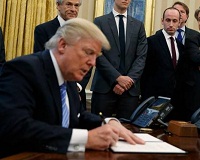
President Trump took first step towards implementing his economic agenda --- signing an executive action removing the US from a free trade deal Trans-Pacific Partnership (TPP). This was one of Trump’s core campaign promises. The accord negotiated by the Bush and Obama administrations has been held. The Obama Administration had pushed for the 12-country regional free trade agreement, arguing it was a vital national security priority to compete with a rising China.
TPP a non starter from the beginning
Trump’s decision not to join the TPP was expected as during his election campaign he railed against international trade deals, blaming them for job losses and focusing anger in the industrial heartland.
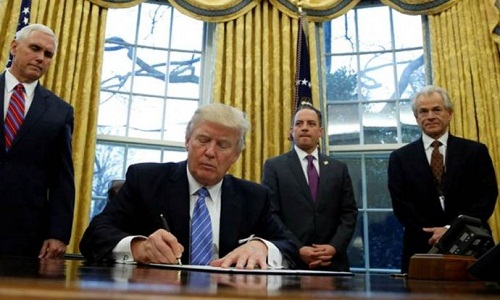
TPP negotiations had begun almost 10 years ago and designed to create major changes in the economies of the 12 signatory countries. The countries involved previously made up 40 per cent of the world economy. The agreement began as almost casual negotiations between New Zealand, Brunei, Singapore and Chile but rapidly expanded. The final agreement was signed by Brunei, Canada, Chile, Japan, Malaysia, Mexico, New Zealand, Peru, Singapore, United States, Vietnam and Australia. Each country needed to pass and ratify associated legislation for the partnership to begin.
What’s in it for fashion companies
A number of footwear and apparel brand and organisations, including the Footwear Distributors & Retailers of America and the American Apparel & Footwear Association as well as brands, such as Nike, New Balance, Gap, and Hanes, have been opposing TPP. These parties have cited the TPP's promise to eliminate more than 18,000 taxes and other trade barriers, strengthen ties among member countries and increase economic growth. According to Matt Priest, President, Footwear Distributors & Retailers of America, the TPP was all about the inclusion of Vietnam, a hub of shoe manufacturing, and that’s where lies the interest of American companies. If there are any better trade pacts to fructify tie-up with Vietnam, we would be keen to scrap the TPP. Agreeing on the same, Julia K. Hughes, President, US Fashion Industry Association, echoed this notion, that free trade agreements are important to our sector.
TPP-12 minus one the next step…
However, even though the US is out of the treaty others are promising to go ahead with the deal. Australia and New Zealand say they are hopeful of pressing ahead with the Trans Pacific Partnership trade deal, despite America's formal withdrawal. Australia has already devised a name for a possible new agreement: TPP 12 Minus One. The US-led, 12-nation agreement was set to cover 40 per cent of the world's economic output. Australian Trade Minister Steve Ciobo said on Tuesday it would require "a little bit of elbow grease" to orchestrate a plan B with the remaining TPP members, including Japan, Mexico and Canada, but goodwill remained to "capture the gains" made under the agreement.
Ciobo says he had conversations with Canada, Mexico, Japan, New Zealand, Singapore, Malaysia about the deal. "I know that there's been conversations that have been had with Chile and with Peru. So there's quite a number of countries that have an interest in looking to see if we can make a TPP 12 minus one work," he said. Ciobo also said the original architecture of the TPP was designed to enable other countries to join. So Indonesia has expressed a possible interest and there would be scope for China if they are able to reformulate it to be a TPP 12 minus one for countries like Indonesia or China or indeed other countries to consider joining and to join in order to get the benefits that flow as a consequence.
New Zealand Prime Minister Bill English too has said he is hopeful of keeping a free trade deal alive with remaining members of the TPP agreement, while the country's trade minister Todd McClay expected TPP ministers would meet in the coming months to navigate a way forward.
Meanwhile China, which was left out of the TPP deal, has its eye on its own regional trade pacts. It has suggested a Free Trade Area of the Asia Pacific and is supportive of the Regional Comprehensive Economic Partnership (RCEP), which could see a free trade deal between countries including Australia, China, India, Japan, South Korea and New Zealand.
"Contributing 7 per cent to the country’s GDP, and consisting of more than 55,000 textile and clothing companies that provide two million textile jobs, Turkish textile industry has come off age. In 2015, textiles and clothing products accounted for 19.2 per cent of Turkey’s total exports. With textile industry being largely cotton-based, Turkey is the world’s third-largest cotton importer, as domestic output is not sufficient to meet demand. Having said that, cotton production in Turkey is slated to rise by 15 per cent this year, growing to 425,000 hectares of planting area and 650,000 tonne of total cotton production."
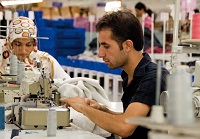
Contributing 7 per cent to the country’s GDP, and consisting of more than 55,000 textile and clothing companies that provide two million textile jobs, Turkish textile industry has come off age. In 2015, textiles and clothing products accounted for 19.2 per cent of Turkey’s total exports. With textile industry being largely cotton-based, Turkey is the world’s third-largest cotton importer, as domestic output is not sufficient to meet demand. Having said that, cotton production in Turkey is slated to rise by 15 per cent this year, growing to 425,000 hectares of planting area and 650,000 tonne of total cotton production.
Global uncertainties a fear
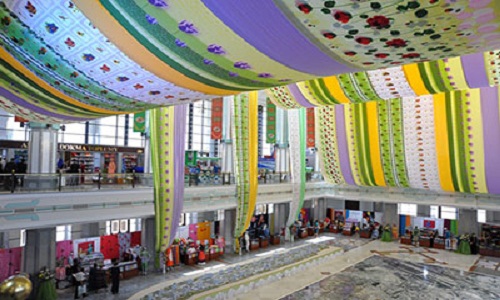
The EU has now become Turkey’s top export partner with a share of 48.1 per cent of Turkish exports. However, the looming threat of Brexit may change that. Also, with Donald Trump as President of the US a lot is expected to change for Turkey’s textile industry but how exactly it will change remains uncertain. Many textile and fabric manufacturers in Turkey fear the Trump administration may place hefty tariffs on goods imported to the US from Turkey, but whether or not this will become reality remains unclear as of yet.
Meanwhile Turkey itself is facing upheaval and threats to public safety. In 2016, Turkey experienced multiple ISIS-related bombings and terrorist attacks, the most widely reported one being the attack on Istanbul’s Ataturk Airport in June 2016. This increase in terrorism is causing many Western clients and consumers to avoid doing business in Turkey. Turkey has lost its traditional markets in the region for its exports—Yemen, Iraq, and Syria—to civil war and other political and humanitarian crises.
Russia was once also a large market for Turkish textiles but Russia-Turkey relations have been on the decline since November 2015 when Turkey shot down a Russian jet; in retaliation Russia imposed economic sanctions on Turkey. Though the economic damage to the textile market—and numerous other markets—has already been done, the two countries have since worked together to try and rebuild their partnership.
Impact of Syrian crisis
Syria was once an important supplier of raw materials for Turkish textiles, but the Syrian crisis has drastically changed this. The economy and most industrial production markets in Syria have been decimated. The Islamic State now reportedly controls Syria’s cotton production and supply and Turkey officially refuses to accept imports of ISIL-controlled cotton. As Syria has traditionally been one of Turkey’s main suppliers of raw cotton, this is negatively impacting Turkey’s textile industry and forcing them to look for other ethical but high-priced sources of cotton.
Additionally, Turkey is now home to more than 2.5 million Syrian refugees. More than 660,000 school-age Syrian children in Turkey are not in school; a large percentage of these children are illegally working textile jobs in order to help provide for their families and make ends meet.
Positive steps towards improvement
Currently, Turkey does not recognise Syrian refugees as refugees; it instead puts them under ‘temporary protection’, which offers them more rights than traditional refugee status but for a shorter period of time. The Turkish government claims that it is taking steps towards better protecting Syrians in Turkey, particularly children, and are putting measures in place to punish companies that exploit unregistered or underage refugees for labour.
Turkey is also expected to increase its cotton production this year, which will put it on track to become less dependent on external sources of cotton, saving the textile and apparel industry both money and ethical dilemmas. Working to improve relations with Russia will also boost the textile industry.
The Turkish Government’s ‘Turquality’ programme is also expected to help boost the textile and apparel market in the country. The programme is intended to provide subsidies to companies and manufacturers in order to assist with marketing and strategic positioning of products.
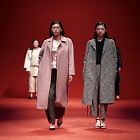
Chic Spring 2017 will take place from March 15 to 17 in Shanghai. This show, termed as Asia´s largest fashion trade show, will again attract the international world of fashion.
As many as 1,200 international and national fashion exhibitors will present new trends and tendencies for fall/winter 2017/18 at this show. More than 100,000 trade visitors from all over China and other nations are expected to visit the exhibition too.
In the international segment, a total of 18 regions and nations will be participating. Among them, there would be big national pavilions from countries like Italy, France and Germany. Turkey will be present with a national pavilion as well. Further individual exhibitors would come from Spain, UK and Switzerland. Also present would be Peru, Japan, Taiwan, Hong Kong, South Korea, Canada and Thailand.
Due to the high demand for shoes and bags in the Chinese market, special attention will be paid to these product categories in all segments of the fair. For the first time Chinese brands will be concentrated under the title Shanghai Bag Expo at the show. Technical progress in the fashion industry will be a topic at CHIC. Companies such as Regentsoft and Qishon will present their innovations in the fields of software for multi channel solutions 3D technology.
Premium sportswear brands from around the world are making a beeline for Korea. One such is Under Armour, a US-based sportswear brand known for its sweat-absorbing compression shirts. Another is Lululemon Athletica, a Canadian yoga apparel brand dubbed the Chanel of yoga apparel because of its high price tags and premium quality.
In contrast to the sluggish fashion industry, Korea’s sportswear market has shown continuous growth. Last year, sales showed a 5.8 per cent year on year increase from 2015. Sales this year are expected to rise 4.4 per cent. K2 Korea, an outdoor-oriented fashion group, will bring German sportswear brand Dynafit to Korea this spring. The brand was originally a ski gear manufacturer. It will rebrand itself as a training and running apparel brand in Korea.
Fitness freaks in Korea will have abundant apparel choices starting this year. In response to foreign brands’ arrival, domestic fashion houses are gearing up to go head-to-head with them. LF, a fashion arm of LG Group, will launch a sports line of its New York-based brand Jillstuart with this year’s spring/summer collection. It is the first time that LF will present a sportswear brand that includes diverse sports categories, from training to yoga. The company will open 150 shops by 2020.
India has the opportunity to improve its share of global trade, especially in exports, through increased competitiveness. It will probably be the only country to deliver nearly double-digit growth in container trade this year.
Reducing costs by a fourth can substantially boost exports in sectors like textiles, pharmaceuticals, electronics and auto components. Costs can be reduced by prioritizing digitization, inland infrastructure development, an efficient regulatory environment and developmental training. These can boost exports by five to eight per cent.
Indirect or hidden costs of trade in textiles, pharmaceuticals, electronics and auto components accrue from unreliable transport services and regulatory or bureaucratic delays and are as high as 38 to 47 per cent of the total logistics cost. A ten per cent reduction can boost India’s competitiveness and contribute additional revenues of up to 5.5 billion dollars annually.
Indian ports and terminals are well placed to deliver efficiencies and higher productivity. Terminals can collectively contribute better to lowering costs of trade with certain interventions such as market driven tariff regime, better rail connectivity from ports and reducing middle men or increasing transparency in inland movement of cargo.
APM terminals in Nhava Sheva has consistently increased its container throughput and productivity since 2006 and as a result has improved India’s liner shipping connectivity, delivering an additional nine per cent in trade.
Solapur-based garment units manufacturing readymade school and corporate uniforms have drawn up plans to achieve Rs. 1,000 crore in revenues in the next two years, according to a top official. Joint Secretary, Sri Solapur Readymade Kapad Utpadak Sangh, Amit Kumar C. Jain said that the units in Solapur can easily do a business of Rs. 1,000 crore in two years. He said that the Sangh had recently conducted a uniform and garments fair which would fetch an additional business of Rs 200-250 crore. They have also received enquiries from international buyers based in Sudan, Iran, Iraq, Czech Republic and Kenya for readymade school uniforms. So much so, representatives from Sudan have also eveinced interest in putting up a manufacturing unit in Solapur, he claimed.
There are more than 1,000 garment units in Solapur employing more than 60,000 people. The units do an annual business between Rs 600-650 crore and boast a market share of 7 to 8 per cent, he said. The Indian readymade uniform market size is pegged at Rs. 18,000 crore, of which the organised sector accounts for nearly Rs 12,000 crore. Uniform-making units are scattered across seven to eight major cities such as Tirupur, Kolkata, New Delhi, Mumbai, Indore and Ludhiana.
Pakistan Prime Minister Nawaz Sharif has unveiled the much-awaited textile package worth Rs 180 billion. In the current year, the government has already provided a reduction in power tariff and has tried to provide uninterrupted power supply to the textile industry. Moreover, five exports sectors have already been declared zero rated. Now, the government is trying to appease powerful stakeholders in some or the other way since the election campaign is gaining momentum each day.
The package was delayed by a couple of years. When international prices started to decline in 2013-14, the exporters somehow needed this package anyway. On the external front, exporters were getting lower prices for their products. On the internal front, they faced gas and electricity load-shedding and even higher power tariff. Caught by the electricity issue in the beginning, the government turned a blind eye.
Small and medium sized exporters were hurt when rupee appreciated against dollar from 105 to 98. Many went out of business due to forex volatility. That was the time when exports started to decline and industry clamoured for a relief package, but the government denied it. By keeping rupee strong for so long, the government has aggravated the problems of exporter since exports are of low value-added nature which cannot command higher prices. Under these circumstances, a planned package is required to upgrade the industry.
The package is a generic one without a differentiation strategy. There is always a need to differentiate between small and large exporters. In an ideal situation, small exporters are subsidies dependent, while large exporters can easily look after themselves. The span of the package is short it will last 18 months. The first six months of the package are unconditional that the export subsidies would be given out without any commitment from the industry. The rest are conditional on expansion of exports. In this short span, the industry cannot re-orient itself and gear for high exports. Furthermore, the chances of new entrants in the export business are minimal.
Denim trends for 2017 include mom jeans, cropped kick-flares and customised pieces. Mom jeans are high-waisted with a tapered leg. They look just as good with trainers as they do with a pair of heels. A waist belt helps bring balance. The cropped kick flare flatters most body shapes thanks to the cut of the leg. Customised jeans have fringes, super rips and step hems, with embroidery and badge details.
Since distressed edges have come and gone, as also culottes, high waist jeans and the boot cut. So the way forward is super-low-cut, low-rider jeans. On the catwalk, designers now mix jeans with their hand-beaded evening gowns. Low rise jeans are expected to be back in a year. Boyfriend jeans often have a turn-up. They can be paired with pointed heels and a jacket, or with chunky boots and an embroidered sweater.
Flares of all lengths are in. Authentic, vintage-looking blue jeans with minimal stretch and a high rise are in. The high rise non-stretch jean with a slim tapered leg is trending. Cropped flares are continuing to have a real moment. Vintage silhouettes remain the key players in fashion denim. Double frays are an alternative to wearing distressed jeans in places like the office, where rips and holes go too far.












